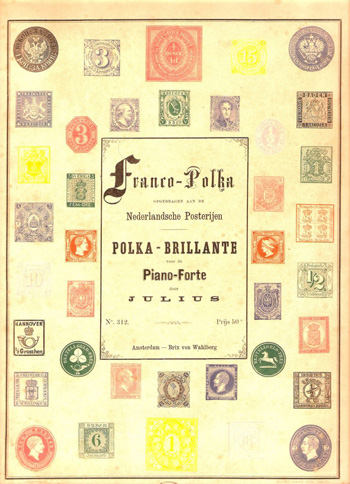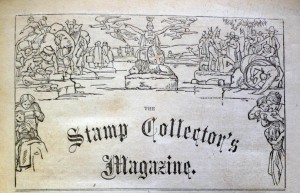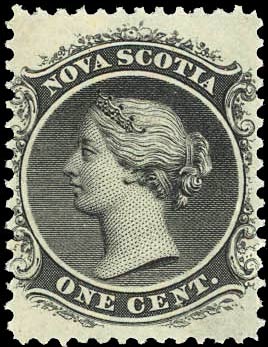
 Before we begin with trickery and deceit I want to refer back to the ‘Stamp Polka’ described in The History of Stamp Collecting Part 22. Alas, up to now I have not been able to find a picture of the “Briefmarken-Polka für das Pianoforte” (The Postage Stamp Polka for the Pianoforte) sheet music front page, but I received the image below from Jan Vellekoop – the Dutch version of the Stamp Polka, published in 1864.
Before we begin with trickery and deceit I want to refer back to the ‘Stamp Polka’ described in The History of Stamp Collecting Part 22. Alas, up to now I have not been able to find a picture of the “Briefmarken-Polka für das Pianoforte” (The Postage Stamp Polka for the Pianoforte) sheet music front page, but I received the image below from Jan Vellekoop – the Dutch version of the Stamp Polka, published in 1864.

Now on to trickery and deceit. We have already seen in this series that counterfeits have existed almost since the first postage stamps were issued, greatly increasing from 1862, the year stamp collecting and trade grew enormously. In 1863 several publications frequently warned for counterfeits, especially those coming from Nuremberg (Georg Zechmeijer?).

In the last edition of ‘The Stamp Collector’s Magazine’ from 1863, is an article which gives a good picture of collecting at that time:
On the Increase of the Timbromanie
One of the greatest maxims in commerce is, that wherever there is a demand there will be a supply. This has proved true in a remarkable degree in the case of stamps. Two years ago, the rising taste for collecting these little labels had scarcely a purveyor: now not only in London and all the great provincial cities, but even many smaller towns, such as Hull, Dover, Hartlepool and Ipswich, contain dealers – many of them, doubtless, doing a good trade; and month by month, the number of addresses presented in The Stamp Collector’s Magazine increases.
There is probably no kind of timbre post which may not be obtained from one or other of these enterprising firms. The increased competition has naturally induce a great fall in the prices.
The few solitary individuals who have been accumulating collections for many years and who now are left behind by the general rush, never thought of troubling themselves about clean copies, but were quite content with such as came to them and their friends on letters.
Consequently, obliterated stamps remained in the ascendant among the earlier victims of the present mania; and the oldest dealers’ lists offer little else to the purchaser. Moreover, the prices affixed to the different kinds would now be regarded as ridiculous, if demanded for clean specimens. But time passed on; friends, collectors and postmasters in the colonies were communicated with; the new demand brought abundant supplies, and ‘immaculates’ became the rage. These, in many cases, have already reached a discount of 70 to 80 per cent. on the prices originally asked; and the reduction will doubtless continue for some time longer. Thus the beautiful one-cent Nova Scotia, which a year ago fetched a shilling, may now be had for a penny; and the corresponding New Brunswick, for which the same price was demanded, though it had passed through the post, now sells for a penny when clean.*
Stamp collecting does not yet wane; and there is no reason why it should not remain, like the kindred manias for accumulating coins or books, as a permanent institution in our land. In our opinion the present possesses several advantages over these two ‘follies’; for the comparative cheapness and small bulk of its objects, and the ease with which they may be obtained, are a great recommendation.”
So much for the article from The Stamp collector’s magazine.
What was demonstrated here is that postal administrations, as a result of collectors’ demands, provided unused stamps, which were thus no longer to be used as stamps were originally intended – as a means of paying for postal delivery. From this period, many postal administrations found this to be a lucrative part of their business and they began to issue new stamps more regularly – it was especially lucrative in periods when collecting stamps was popular (and there have been many peaks and troughs over the last 150 years). The unused stamps from those periods are now usually very cheap and often franked stamps are more expensive or harder to find. This is in contrast to periods with less collective interest or economic prosperity. At the moment, we are in a period of less collective interest, but because most postal administrations are now really commercial and profit growth is a target, the lesser interest is offset by more and more expensive issues, which unfortunately excludes many collectors. In my view, this trend has not been manifested so clearly in the last hundred and fifty years. In the past, less demand usually resulted in fewer issues.

*In the Michel catalogue the above-mentioned 1 cent Nova Scotia is valued at €4.50 unused and €18.00 used. Incidentally, there are many forgeries of this stamp in circulation.
![]()

I think I have a copy of the front of the that sheet music,Briefmarken-Polka für das Pianoforte” (The Postage Stamp Polka for the Pianoforte) , that you are referring to. I found it framed in my grandmothers attic.